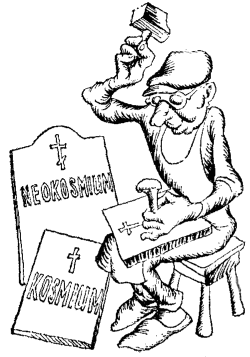107Stories About ChemistryINDEX |
35.
On the Track of False Suns
In the eighties of the last century one of the chemical journals published a curious article. The author, hardly known to the scientific world, reported that he had succeeded in detecting two new elements at once. And he gave them the pompous names of kosmium and neokosmium. At that time the discovery of new elements had become quite a mass phenomenon.  Some investigators did not even take the trouble to think up names for the �newborn� elements and denoted them by letters of the Greek alphabet. It soon became apparent that the �discoverer� of kosmium and neokosmium had just been making fun of this discovery epidemic. The article was a kind of April-Fool joke. The author�s name was Kosman. There are one hundred and four elements in the Periodic Table. One hundred and four actual discoveries of elements have been registered in the history of science. Besides this list, there is another one, incomparably longer, including several hundred names. Such is the �church calendar� of stillborn elements, those that came to life as a result of delusions, experimental errors, and sometimes simply carelessness on the part of investigators. Long and thorny was the path of the discoverers of new elements, like a path through a thicket which keeps losing itself among narrow crevices. Next to it ran another path, a beaten track. But the latter was the track of false suns, of false discoveries of chemical elements. And oh, the number of queer things and paradoxes encountered on this track! The Kosman case was literally a drop in the ocean. The Englishman Crookes isolated from yttrium a host of new simple substances which he called meta-elements. Actually they were simply mixtures of long known elements. Swienne, a German scientist, sought the transuranium elements in samples of that was thought to be cosmic dust collected among the glaciers of Greenland by the famous polar explorer Nordenskjold. And he hurried to report that he had succeeded in finding an element with the atomic number 108 in the dust. The truth was not long in striking back. The ill-starred scientist had simply been under the illusion of an incorrect theoretical idea. One cannot help recalling the Englishman Freehand who organized a special expedition to Palestine to �fish� for traces of elements No. 85 and No.87 in the lifeless waters of the Dead Sea. Or the American Allison who, while scientists puzzled over the question why no heavy analogues of iodine and cesium could be found on Earth suddenly began discovering them everywhere. He detected them in all solutions and minerals checked by a new method he had worked out. The method turned out to be faulty. The analysis greatly fatigued the operator�s eyes and caused illusions. Even great men have not escaped errors on the track of false suns. The Italian Fermi thought that several transuranium elements at once appeared in uranium on bombardment with neutrons. Actually these were the fission fragments of uranium nuclei, elements of the middle of the Periodic System. This notorious track persists even in our days. In 1958, a group of scientists in Stockholm synthesized a new element with the atomic number 102. It was named nobelium in honour of the inventor of dynamite. Soviet and American researchers disproved these results. And now the scientists say jestingly that all that is left of nobelium is its symbol �No.� However, isotopes of the 102nd element have now been obtained quite authentically by other methods in the U.S.S.R. and the U.S.A. |





